Opening this fall on October 7, The Phillips Collection presents an exceptional exhibition inspired by the museum’s celebrated Luncheon of the Boating Party (1880–81) by Pierre Auguste Renoir. Comprised of more than 40 carefully chosen works from private and public collections around the world, Renoir and Friends: Luncheon of the Boating Party explores the process by which the artist created his masterwork, while also recounting and illustrating stories of the diverse circle of friends who inspired it.
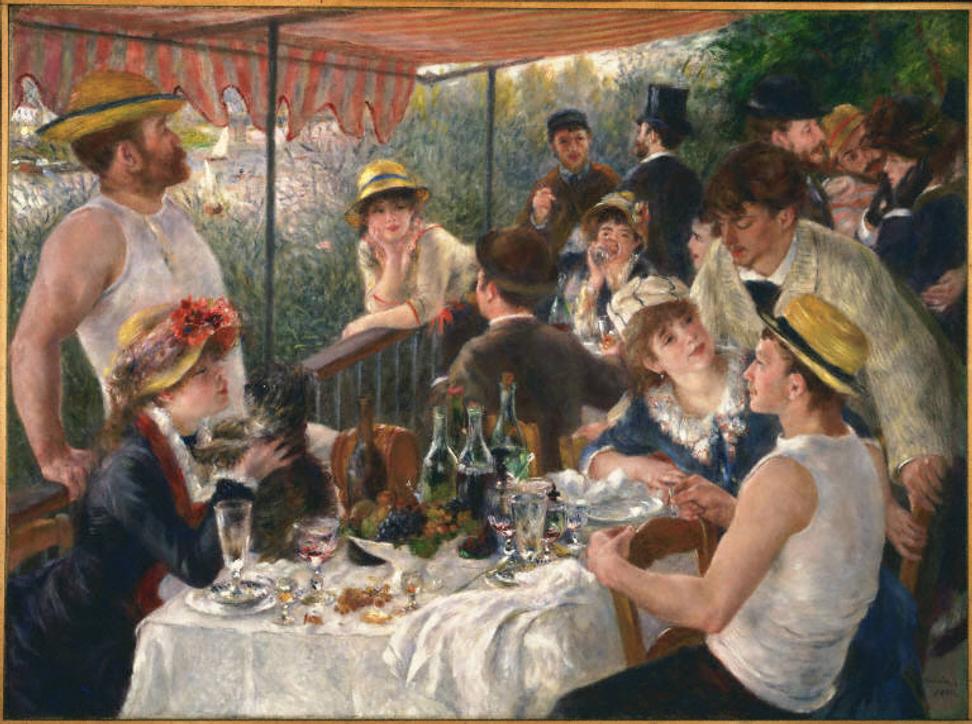
- Pierre-Auguste Renoir, Luncheon of the Boating Party, 1880–81. Oil on canvas, 51 1/4 x 69 1/8 in. The Phillips Collection, Washington, DC, Acquired 1923
“As the Phillips draws closer to our centennial year, it is a very fitting time to shed new light on one of the gems of our permanent collection,” said Phillips Director Dorothy Kosinski. “I am delighted that Renoir’s masterwork will be displayed alongside numerous other works by the artist and his contemporaries, helping further contextualize this remarkable painting.”
Recognized today as one of the greatest achievements of the artist’s career, the work is a marvel of plein-air painting on a grand scale. While no known preparatory studies exist for this masterwork, the years before Renoir completed Luncheon of the Boating Party were marked by encounters with riverside locations along the Seine west of Paris and with specific individuals who helped him realize his ambitious undertaking. No other large-scale painting by Renoir with the exception of the

Dance at the Moulin de la Galette (1876) comprises as many figures as Luncheon of the Boating Party. While never intended as a group portrait, the 14 individuals depicted in the painting appear nonetheless highly individualized and based on specific people in Renoir’s life.
“Luncheon of the Boating Party represents so much more than a diverse group of friends having a lovely time,” said Phillips Chief Curator Emerita, and project director, Eliza Rathbone. “Much has been written about Renoir and his work. Our project seeks to separate fact from fiction and to uncover as much specific detail and evidence as possible in order to bring to life this group of journalists, critics, models, collectors, and world travelers. By looking closely at these individuals who inspired Renoir, we find ourselves in a fascinating backstory that sheds light not only on this great enterprise and its models but on the artist himself.”
A room in the exhibition dedicated to research on the masterwork will feature an in-gallery interactive that uses findings from x-radiographic and infrared images and paint cross-sections.
“Drawing upon a recent technical study on Luncheon of the Boating Party, I am excited to share new discoveries made about the painting,” said Phillips Head of Conservation Elizabeth Steele. “Inspection of the surface in raking light compared to the same passages in x-radiographic and infrared images reveal numerous changes that the artist made while completing the painting, and scientific analysis of the paint layers further illuminates these revisions. Through richly illustrated text panels and a groundbreaking in-gallery interactive, visitors will for the first time be able to track Renoir’s development of the composition on their own.”
GETTING TO KNOW THE BOATING PARTY
While never intended as a group portrait, the individuals depic ted in the painting appear nonetheless highly individualized and based on specific people in Renoir’s life. Figures seen in Luncheon of the Boating Party who were especially influential during Renoir’s career include his wife and frequent muse Aline Charigot, artist and boating enthusiast Gustave Caillebotte, and art critic and collector Charles Ephrussi.
Displayed alongside the famed masterpiece will be rare and iconic works by the artist and his contemporaries that offer insight into Renoir’s fascinating group of friends. Aline Charigot appears in important works that include

Pierre-Auguste Renoir, The Dance in the Country , 1883. Oil on canvas, 70 7/8 x 35 7/16 in. Musée d'Orsay, Paris / Bridgeman Images
Dance in the Country (1883) from the Musée d'Orsay
as well as loans from the Rhode Island School of Design Museum; Museum of Fine Arts, Boston; Philadelphia Museum of Art; among others. A rich spectrum of works by Renoir’s close friend Gustave Caillebotte will also be on v iew.

Gustave Caillebotte, A Man Docking His Skiff , 1878. Oil on canvas, 29 x 36 1/2 in. Virginia Museum of Fine Arts, Richmond, Collection of Mr. and Mrs. Paul Mellon. Photo: Katherine Wetzel © Virginia Museum of Fine Arts
Highlights include Gustave Caillebotte A Man Docking His Skiff (1878) from the Virginia Museum of Fine Arts, and

The Yellow Boat (1891) from the Norton Simon Museum,
and rarely seen loan s from private collections.
The stories of Renoir’s models will also be told through photographs, prints, drawings, and even a small selection of hats, on loan from the Museum of the City of New York, similar to those worn by the individuals depicted.
Just as Phillips imagined it would be when he bought the painting in 1923, Luncheon of the Boating Party by Renoir remains the best known and most popular work of art at The Phillips Collection. The painting captures an idyllic atmosphere of friends sharing food, wine, and conversation on a balcony overlooking the Seine at the Maison Fournaise restaurant in Chatou. Parisians flocked to the Maison Fournaise to rent rowing skiffs, eat a good meal, or stay the night. The painting also reflects the changing character of French society in the mid‐to late 19th century. The restaurant welcomed customers of many classes, including businessmen, society women, artists, actresses, writers, critics, seamstresses, and shop girls. This diverse group embodied a new, modern Parisian society.
Renoir and Women Models
Renoir celebrated not only natural female beauty but also a wom n’s attire and the way in which the line of a dress or shape of a hat could flatter her appearance. The son of a tailor and a dressmaker, he naturally came by this appreciation for line, texture, and style. Friends and mistresses would pose for him as a favor, but he also hired models in Montmartre. His friend Georges Rivière described how Renoir diplomatically persuaded certain young women to model for him by charming their mothers,
Among those who appear in Renoir’s work numerous times in the late 18 70s and early 1880s were three actresses—Ellen Andrée, Angèle (who also made a living as a florist), and Jeanne Samary—as well as Alphonsine Fournaise, daughter of the owner of the Maison Fourn aise, whom he often saw at her father’s establishment in Chatou.
In his desire to paint scenes from contemporary life, Renoir preferred to depict individuals in their familiar surroundings.
Aline Charigot
Aline Charigot spent her childhood in the village of Essoyes, but came to Paris to join her mother in 1874, and lived not far from Renoir ’s studio on rue Saint Georges. She probably met Renoir in 1879, when she was 20 years old. She was younger than Renoir by 18years, entering his life as he was beginning to receive the recog nition and commissions necessary to stabilize his ca eer. In 1885 they had their first child, and in 1890 they were married. They had three sons: Pierre, Jean, and Claude. According to Jean’s descriptions of his mother, she was the ideal partner for his father: a generous companion who never lost her love of the countryside, and when they acquired their property in Cagnes, was ready to roll up her sleeves and work the land. She served as a regular model for her husband, and, according to Jean, all his father’s paintings of women after he met Charigot resemble her to some degree.
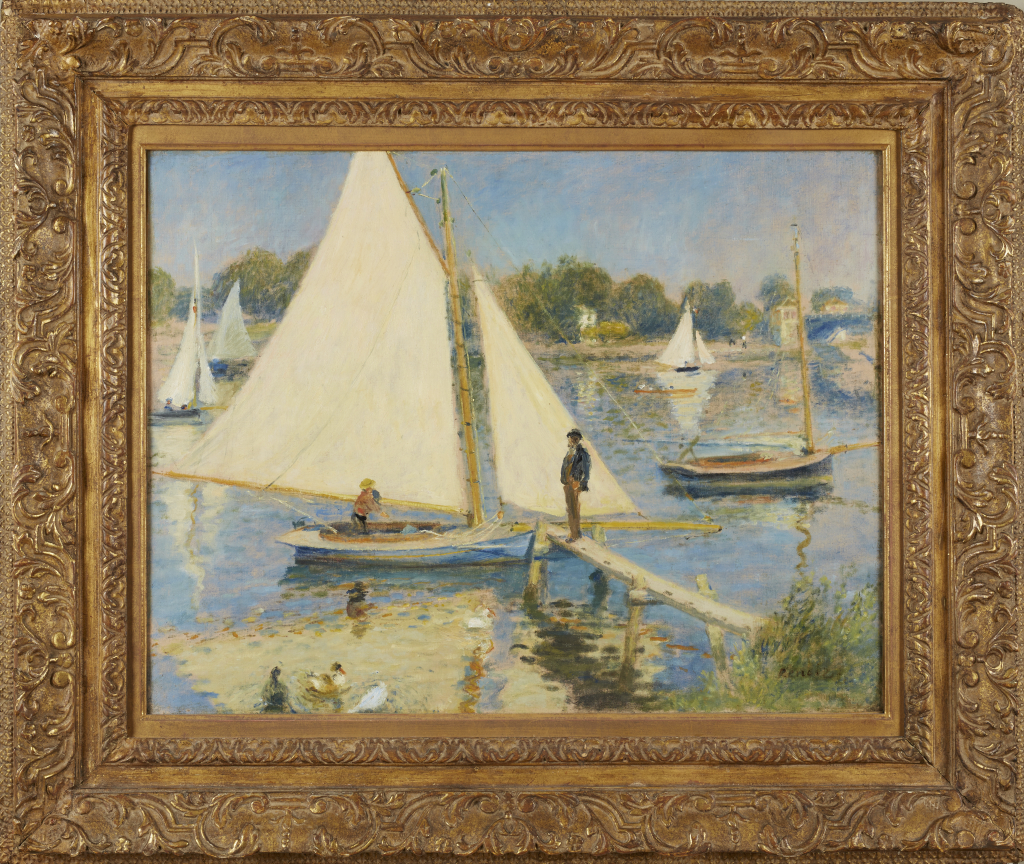
Pierre-Auguste Renoir, The Seine at Argenteuil , 1874. Oil on canvas, 19 3/4 x 25 3/4 in. Portland Art Museum, Oregon, Bequest of Winslow B. Ayer
PIERRE‐AUGUSTE RENOIR (1841–1919) The Seine at Chatou (La Seine à Chatou) 1874 Oil on canvas Dallas Museum of Art, The Wendy and Emery Reves Collection During the 1870s, Renoir often vis ited Chatou, the site of the Maison Fournaise, where he painted Luncheon of the Boating Party . In his lively rendering of a gusty day on the water, Renoir i ncludes a sailboat, signaling in his paintin g the growing popularity of t he sport. The Phillips Collection thanks Alan Inouye for his support in b ringing this work to Washington.

Pierre-Auguste Renoir, Lunch at the Restaurant Fournaise (The Rower’s Lunch) , 1875. Oil on canvas, 21 5/8 x 25 15/16 in. The Art Institute of Chicago, Potter Palmer Collection
Pierre-Auguste Renoir, Oarsmen at Chatou, 1879. Oil on canvas, 31 15/16 x 39 7/16 in. National Gallery of Art, Washington, DC, Gift of Sam A. Lewisohn

Pierre-Auguste Renoir, Young Woman Reading an Illustrated Journal, 1880. Oil on canvas, 18 1/4 x 22 in. Museum of Art, Rhode Island School of Design, Providence, RI, Museum Appropriation Fund 22.125

Pierre-Auguste Renoir, Boating Couple [said to be Aline Charigot and Renoir] , 1880–81. Oil on canvas, 17 3/4 x 23 in. Museum of Fine Arts, Boston, Given in memory of Governor Alvan T. Fuller by the Fuller Foundation
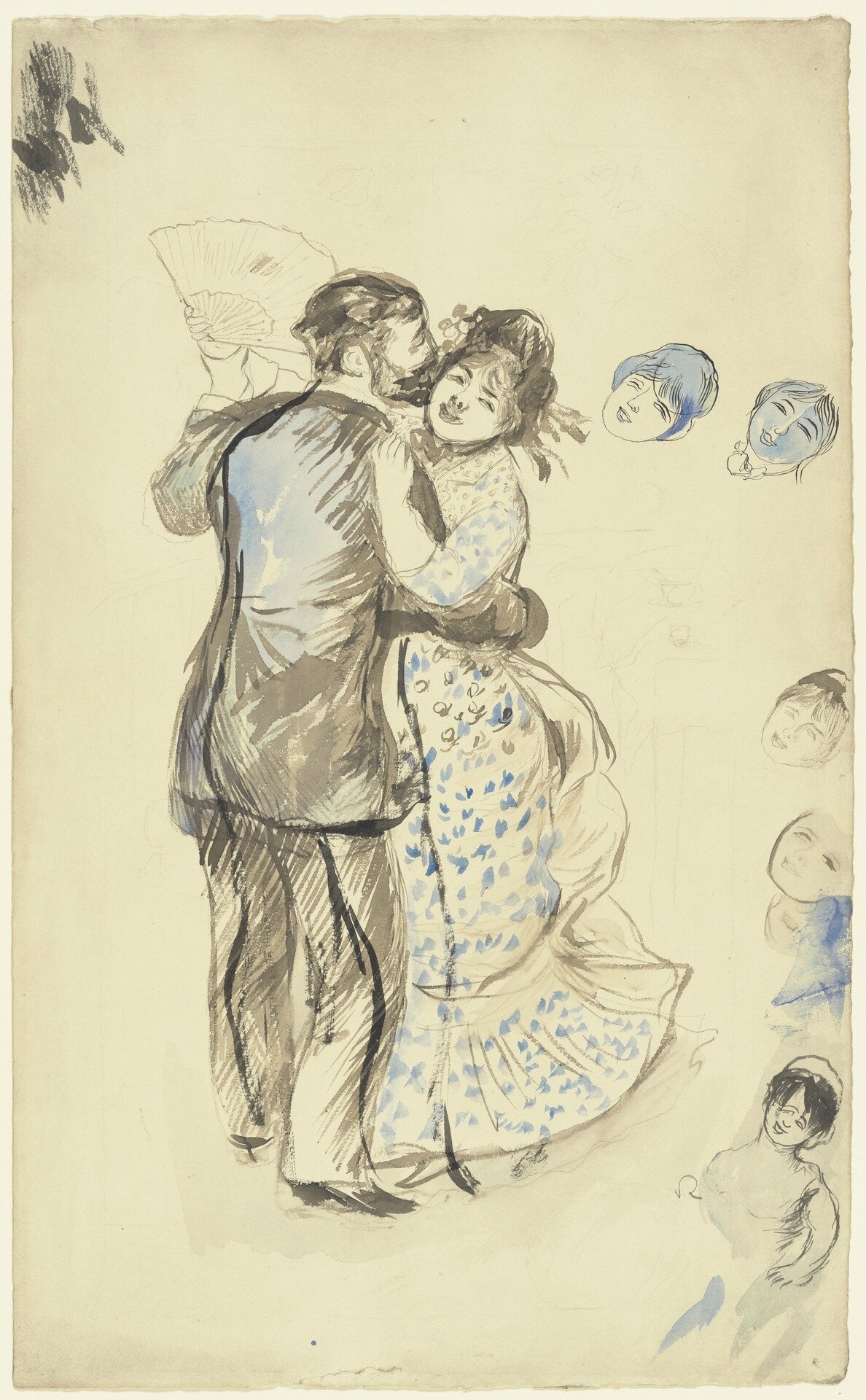
Pierre-Auguste Renoir, Dance in the Country , 1883. Brush and brown, blue, and black wash over black chalk or graphite, 19 1/2 x 12 in. Yale University Art Gallery, Bequest of Edith Malvina K. Wetmore

Gustave Caillebotte, Sailboats on the Seine at Argenteuil, 1893. Oil on canvas, 28 7/8 x 17 in. Private collection
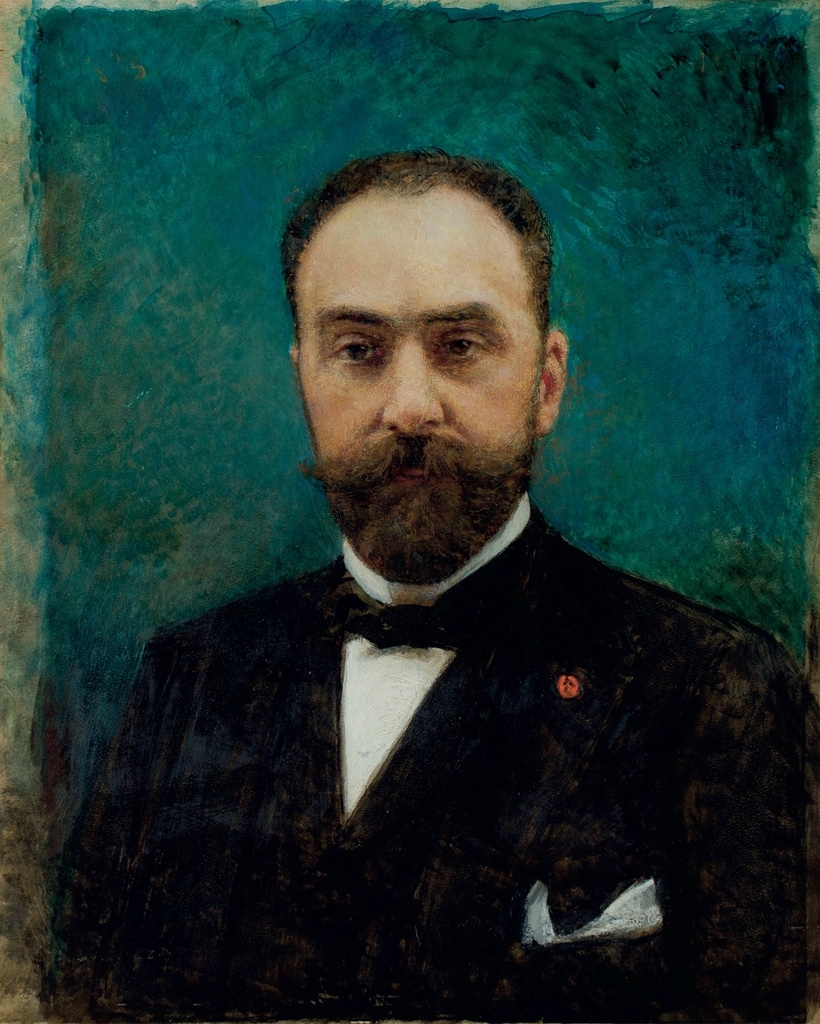
Léon Bonnat , Portrait of Charles Ephrussi , 1906. Oil on canvas, 18 x 15 in. Private collection. Photo: Vincent DUFOURNIER
Success came slowly to Renoir. The Franco‐Prussian War of 1870– 71 caused economic depression in France. Impressionism was controversial and not well received by tradition‐bound critics and institutions. But the establishment of the Third Republic broug ht a tide of optimism and prosperity that lifted Renoir’s fortunes toward the end of the decade. Keenly a ware of the value of personal contacts and social connections, the artist cultivated the support of wr iters who understood and praised his work and collectors who purchased, and soon, in greater numbers, com missioned portraits and decorations.
Among those who helped him weather the challenging years of the 1870s were the very individuals who modeled in 1880 for Luncheon of the Boating Party. A diverse group of men and women—many of them well‐traveled and worldly, many of them stars of their chosen fields, and some of them in positions of significant influence in the art world—these friends offered Renoir essential support and encouragement.
Museum founder Duncan Phillips purchased Luncheon of the Boating Party from the Durand‐Ruel Gallery for the reco rd sum of $125,000 in 1923, just two years after he opened his museum to the public. The only painting by Renoir in his collection, Luncheon of the Boating Party has remained the museum’s greatest treasure.
Gustave Caillebotte
Two documents in the archives of the Durand‐Ruel Gallery tell us that Gustave Caillebotte served as a model for Luncheon of the Boating Party , one of which identifies him sp ecifically as the man in the lo wer right corner of the composition. Renoir’s good friend was not o nly a painter but also a designer of boats, an oarsman, and a distinguishe d yachtsman. By 1879, Caillebotte owned his own sailboat, participated in regattas in Argentue il, and had joined the Cercle de la Voile de Paris (Sailing Club of Paris); he became a vice president of the club in 1880. Born into a family that made its money in the textile business, Caillebotte used his considerable means to support his Impressionist colleagues and to purchase their work. Among his early acquisitions was Renoir’s Dance at the Mou lin de la Galette (1876, Musée d’Orsay), shown at the third I mpressionist exhibition. Caillebotte’s friendship with Renoir was a close one: in 1876, Caillebotte named Renoir executor of his will, and when Renoir and Charigot had their first son in 1885, they asked Caillebotte to be the child’s godfather.

PIERRE‐AUGUSTE RENOIR (1841–1919) The Seine at Argenteuil (La Seine à Argenteuil) 1874 Oil on canvas Portland Art Museum, Oregon, Bequest of Winslow B. Ayer Presumed to have been created on an outing with Claude Monet, w ho painted the same view, this landscape offers Renoir’s interpr etation of a sailboat coming into dock on the Seine at Argenteuil, a location renowned for its sailing regattas that provided a lively plein air subject for Renoir, Monet, Manet, and other fellow Impressionists.

PIERRE‐AUGUSTE RENOIR (1841–1919) The Seine at Chatou (La Seine à Chatou) c. 1871 Oil on canvas Art Gallery of Ontario, Toronto, Purchased 1935 As early as 1869, Renoir was exploring the banks of the Seine west of Paris, seeking subjects for his developing Impressionist style. His mother lived near Louveciennes, not far from Chatou, where he would frequent the Maison Fournaise with its restaurant, lodging, and boats for hire.

PIERRE‐AUGUSTE RENOIR (1841–1919) Boaters of Argenteuil (Canotiers d’Argenteuil) 1873 Oil on canvas Larry Ellison Collection This delightful landscape celebr ates many reasons for leaving the heat, bustle, and filth of Paris for an outing in the country: sailing, rowing, and enjoying river activities from a shady bank.
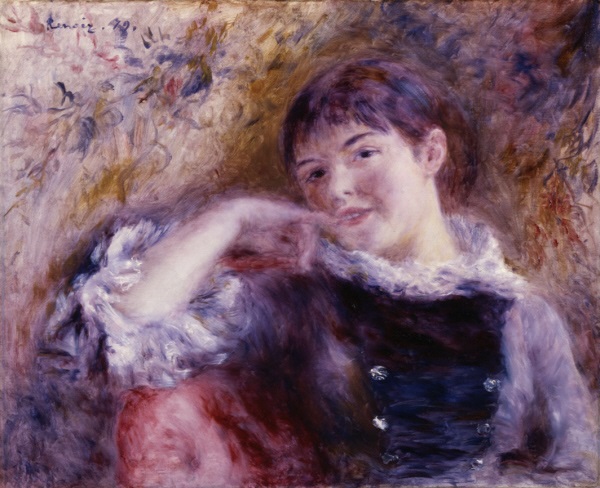
PIERRE‐AUGUSTE RENOIR (1841–1919) The Dreamer (La Rêveuse) 1879 Oil on canvas Saint Louis Art Museum, Museum purchase The model for this painting is thought to be Alphonsine Fournai e, whom Renoir often saw at the Maison Fournaise in the late 1870s. She posed for him regularly during the years leading up to Luncheon of the Boating Party . Although there is no direct evidence that Alphonsine modeled for the young woman leaning on the railing of the balcony in the grand composition, she may have occasionally joined the clientele at the Fournaise in such a way.

PIERRE‐AUGUSTE RENOIR (1841–1919) On the Shore of the Seine (Paysage bord du Seine) c. 1879 Oil on linen The Baltimore Museum of Art, Sadie A. May Bequest, Courtesy of the Fireman’s Fund Insurance Company This quickly executed oil study was probably a gift from Renoir to Alphonsine Fournaise to thank her for modeling for him. In 1864 she married Louis Joseph Papillon, an d we know that a Madame Papillon once owned this piece.
EDGAR DEGAS (1834–1917) Portrait of Ellen Andrée (Portrait d’Ellen Andrée) c. 1876 Monotype in black and brown ink on ivory paper The Art Institute of Chicago, Potter Palmer Collection Ellen Andrée, born Hélène André around 1855, started acting in 1879. She was a favorite of Degas, Manet, and Renoir, using her talents as an actress to play many roles as a model. In the early 1880s she gave up modeling entirely and in 1887 she joined a naturalist t heater, the Teâtre‐Libre. Her career took her to the United States, Argentina, and Russia. She married He nri Julien Dumont, a painter who specialized in flowers. Degas mad e several portraits of her and she modeled for his painting In a Café (L’Absinthe) .
EDGAR DEGAS (1834–1917) The Actress Ellen Andrée (L’actrice Ellen Andrée) 1879 Drypoint Museum of Fine Arts, Boston, Katherine E. Bullard Fund in memo ry of Francis Bullard, by exchange Ellen Andrée is thought to have modeled for Luncheon of the Boating Party as the woman in the center of the composition raising a gla ss to her lips and/or the woman in the lower right corner looking up.
PIERRE‐AUGUSTE RENOIR (1841–1919) Bridge at Chatou (Pont à Chatou) c. 1875 Oil on canvas Sterling and Francine Clark Art I nstitute, Williamstown, Massachusetts This bridge crossing the Seine at Chatou is visible from the balcony of the Fournaise restaurant and can be glimpsed in the background of Luncheon of the Boating Party. The Phillips Collection thanks Greg and Bess Ballentine for the ir support in bringing this work to Washington.
PIERRE‐AUGUSTE RENOIR (1841–1919) Woman with a Fan (Femme à l’éventail) c. 1879 Oil on canvas Sterling and Francine Clark Art I nstitute, Williamstown, Massachusetts Woman with a Fan probably depicts Jeanne Samary. Her dressing room at the Coméd ie‐Française was decorated with striped wallpaper and had Japanese fans on the ceiling. This is one of at least five images of Samary that Renoir made in t he late 1870s. The artist’s son, Jean, wrote that she modeled for Luncheon of the Boating Party , and she has been identified as the woman in the upper right c orner surrounded by admirers. Jeanne Samary—Smiling Digital print from a 19th‐century original Comédie‐Française Bibliothèque‐musée, Paris Famous for her smile and as a brilliant per former of Molière, J eanne Samary dazzled the audience at the Comédie‐Française, where she d ebuted in 1875. She lived with he r parents near Renoir’s studio until she married a banker in 1880. In 1890 she died of typhoid fever at age 33.
PIERRE‐AUGUSTE RENOIR (1841–1919) Madame Renoir with a Dog ( Madame Renoir au chien) 1880 Oil on canvas Collection of Jacques Durand‐Ruel Aline Charigot posed for Renoir’s work on numerous occasions. A lthough she spent most of her adult life in Paris, she never lost her lov e for the countryside, swam “li ke a fish,” according to her son Jean, and enjoyed boating. This painting dates from the summer of 1880, p robably just weeks before the artist embarked on his major undertaking of Luncheon of the Boating Party . [This work may not be photographed]
PIERRE‐AUGUSTE RENOIR (1841–1919) Boating Couple (Les Canotiers) 1880–81 Pastel on paper Museum of Fine Arts, Boston, Given in memory of Governor Alvan T. Fuller by the Fuller Foundation The young woman in this pastel wears a ring on her third finger and holds a bouquet of violets. She gazes into her partner’s eyes a nd is clearly the object of his affection. This intimate pair is thought to represent Aline Charigot and Renoir himself. During the summer of 1880 the couple spent an increasing amount of time together, not lon g before she took on a starring role in his masterwork, Luncheon of the Boating Party .
PIERRE‐AUGUSTE RENOIR (1841–1919) AND RICHARD GUINO (1890–1973) Mother and Child (Mère et enfant) 1916 Bronze The Phillips Collection, Acquired 1940 Based on a painting by Renoir fr om 1885 of Aline Charigot feedi ng their first child, this sculpture is one of several that resulted from a collaboration between the paint er and sculptor Richard Guino. Charigot died in 1915, prompting Renoir to commemorate her in this piece .
PIERRE‐AUGUSTE RENOIR (1841–1919) Young Woman Reading an Illustrate d Journal (Jeune femme lisant un journal illustré) c. 1880 Oil on canvas Museum of Art, Rhode Island School of Design, Providence, Rhode Island, Museum Appropriation Fund Page 8—Wall Text: Renoir and Friends Aline Charigot is the young woma n reading a journal in this int imate scene that reflects her interest in fashion, as well as her close r elationship with the artist.
PIERRE‐AUGUSTE RENOIR (1841–1919) Young Woman Sewing (Jeune femme cousant) c. 1879 Oil on canvas The Art Institute of Chicago, Mr. and Mrs. Lewis Larned Coburn Memorial Collection Charigot, a seamstress, is probably the subject of Young Woman Sewing . Like the painting of the woman reading, it recalls the art of Fr agonard and Vermeer, demonstra ting the deftness with which Renoir could declare his admiration for these masters while also bring ing his subjects into the present in a scene of intimate domesticity.
PIERRE‐AUGUSTE RENOIR (1841–1919) Mademoiselle Charlotte Berthier 1883 Oil on canvas National Gallery of Art, Washington, DC, Gift of Angelika Werth eim Frink Just as Renoir’s friend and fello w artist Gustave Caillebotte p ainted Aline Charigot in the garden of his house at Petit‐Gennevilliers in 1891, so too did Renoir paint C aillebotte’s sweetheart, Charlotte Berthier, though a few years earlier and in a more formal indoor setting.
PIERRE‐AUGUSTE RENOIR (1841–1919) Oarsmen at Chatou (Les Canotiers à Chatou) 1879 Oil on canvas National Gallery of Art, Washington, DC, Gift of Sam A. Lewisoh n The two prominent figures on the banks of the river are traditi onally identified as Gustave Caillebotte and Aline Charigot. An oarsman a ppears to extend an invitation to board, though it is unclear which, if either of them, will accept.
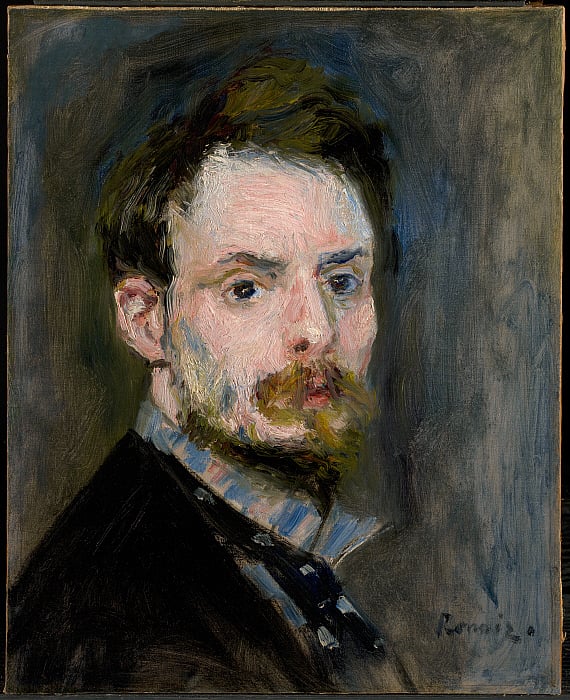
PIERRE‐AUGUSTE RENOIR (1841–1919) Self‐Portrait (Autoportrait) c. 1875 Oil on canvas Sterling and Francine Clark Art Institute, Williamstown, Massachusetts In a rare self‐portrait, Renoir captures the ambitious young ma n that he was in his mid‐thirties, struggling to make a living as a painter. Just a few years late r, as he approached his fortieth birthday, he determined not to put off any longer the challenge of a complex group composition to be painted on the terrace of the Maison Fournaise.
GUSTAVE CAILLEBOTTE (1848–1894) Madame Renoir in the Garden at Petit‐Gennevilliers (Madame Renoir dans le jar din du Petit‐Gennevilliers) 1891 Oil on canvas Collection of Bruce Toll Renoir and Caillebotte were clos e friends until Caillebotte die d of a stroke in 1894 at his home at Petit‐ Gennevilliers. Renoir had painted a portrait of Caillebotte’s l ady friend, Charlotte Berthier, in 1883. Here, Caillebotte produced an informal portrait of Aline Charigot sit ting in his garden. [This work may not be photographed]
PIERRE‐AUGUSTE RENOIR (1841–1919) Man with a Little Hat (L’Homme au petit chapeau) 1877 Oil on canvas Private collection Renoir made two small portraits of his friend Baron Raoul Barbi er in 1877 and 1878. Barbier frequented the Maison Fournaise and was desc ribed by Georges Rivière as a man of inexhaustible energy and goodwill. Barbier modeled for Luncheon of the Boating Party —although Renoir depicts Barbier from the back, he is easily identifiable as he is wearing the same bowle r style hat as in this portrait.
MARCELLIN DESBOUTIN (1823–1902) Portrait of Renoir (Portrait de Renoir) 1877 Drypoint Institut national d’histoire de l’art, Paris Marcellin Desboutin, who showed his work in the third Impressionist exhibition of 1876 and also exhibited at the Salon, made paintings and etchings in a relatively conservative style. Joining the Impressionist group at the Café Nouvelle‐Athènes during the 1870s, he shared their radical views about art and society. In this portrait of Renoir, Desboutin captured his friend’s relaxed intensity as well as his characteristic informality of dress and posture.
PIERRE‐AUGUSTE RENOIR (1841–1919) Georges Rivière 1877 Oil on cement National Gallery of Art, Washington, DC, Ailsa Mellon Bruce Collection
Renoir’s friend Georges Rivière reviewed the second Impressionist exhibition for the journal L’Esprit moderne and the following year he wrote about the “new painting” of the Impressionists for a short‐lived weekly, L’Impressioniste, where he again praised Renoir’s work with lavish enthusiasm.He became a close friend of Renoir, often accompanying him to evening soirées at the home of Marguerite and Georges Charpentier, publishers of La Vie moderne . Fifteen years younger than the artist, Rivière modeled for Dance at the Moulin de la Galette (1876). This profile portrait of Rivière with his strong brows and pencil‐thin moustache may underlie the face in profile at the center of Luncheon of the Boating Party.
Founder Duncan Phillips first encountered Pierre-Auguste Renoir’s Luncheon of the Boating Party in 1911 while he was in Europe and the painting was owned by the artist’s dealer Paul Durand-Ruel. A few years later in a 1914 essay, Phillips was still taken by the masterpiece and wrote that it captured the essence of “life’s vivacity” and the pleasures of “men and women lunching up the river on a hot holiday, the fitful breeze flapping the awnings and the general discussion becoming of more importance than the dessert.” While preparing to establish a museum of modern art and its sources, Phillips started an acquisition strategy that identified significant masterworks to serve as the collection’s foundation. Duncan Phillips’s journals reveal that Renoir’s painting was at the top of his wish list.
By July 9, 1923, only 18 months after the museum opened and just over a decade since Phillips first saw the painting, the Phillips Memorial Gallery reached a deal to purchase the work for $125,000. The very next day, Phillips shared his excitement: “The big Renoir deal has gone through with Durand-Ruel and the Phillips Memorial Gallery is to be the possessor of one of the greatest paintings in the world. The Déjeuner des Canotiers [Luncheon of the Boating Party] is the masterpiece by Renoir and finer than any Rubens—as fine as any Titian or Giorgione….Its fame is tremendous and people will travel thousands of miles to our house to see it. It will do more good arousing interest and support for our project than all the rest of our collection put together. Such a picture creates a sensation wherever it goes.”
Just as Phillips imagined it would be when he bought the painting in 1923, Luncheon of the Boating Party by Renoir remains the best known and most popular work of art at The Phillips Collection. The painting captures an idyllic atmosphere as Renoir's friends share food, wine, and conversation on a balcony overlooking the Seine at the Maison Fournaise restaurant in Chatou. Parisians flocked to the Maison Fournaise to rent rowing skiffs, eat a good meal, or stay the night. The painting also reflects the changing character of French society in the mid- to late 19th century. The restaurant welcomed customers of many classes, including businessmen, society women, artists, actresses, writers, critics, seamstresses, and shop girls. This diverse group embodied a new, modern Parisian society.
Pierre-Auguste Renoir, Young Woman Reading an Illustrated Journal, 1880. Oil on canvas, 18 1/4 x 22 in. Museum of Art, Rhode Island School of Design, Providence, RI, Museum Appropriation Fund 22.125
CATALOGUE

Renoir and Friends: Luncheon of the Boating Party will be accompanied by a full-color catalogue published by D Giles Limited. The publication, edited by Eliza Rathbone (Chief Curator Emerita, The Phillips Collection), will feature Rathbone’s essay along with others by Elizabeth Steele (Head of Conservation, The Phillips Collection), Sara Tas (Curator of Exhibitions, Jewish Historical Museum, Amsterdam), Mary Morton (Curator and Head of the Department of French Painting, National Gallery of Art), Aileen Riberio (Professor Emerita, Courtauld Institute of Art, United Kingdom), and Sylvie Patry (Deputy Director for Collections and Exhibitions and Chief Curator, Barnes Foundation, Philadelphia).


